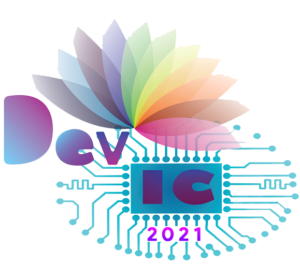Jan 30, 2023
[paper] ULTRARAM Memory on Silicon
Mar 18, 2022
[paper] Compound-Semiconductor Memory on Silicon
Richard Beanland, and Manus Hayne
Department of Physics, University of Warwick (UK)
Jan 5, 2022
[paper] A Review of Sharp-Switching Band-Modulation Devices
1 IMEP-LAHC, Université Grenoble Alpes (F)
2 CEA, LETI, MINATEC Campus (F)
3 CITIC-UGR, University of Granada (SP)
4 Fudan University, Shanghai (CN)
5 Brown University, Providence (US)
Oct 20, 2021
[paper] CMOS floating-gate device for quantum control hardware
2 Istituto di Fotonica e Nanotecnologie, Consiglio Nazionale delle Ricerche (I)
May 12, 2021
4th International DevIC 2021 Conference
 DevIC 2021
DevIC 2021
Conference Date: 19-20 May, 2021
DevIC 2021 Conference committee appeals ALL to contribute in West Bengal State Emergency Relief Fund and assist the State in prevention and control of situation arising out of unforeseen emergencies like COVID-19 (CORONA)
IEEE EDS Kalyani Government Engineering College Student Branch Chapter has decided to contribute to the West Bengal State Emergency Relief Fund to combat the coronavirus outbreak.
IEEE EDS Kalyani Government Engineering College Student Branch Chapter thanks Dr. Wladek Grabinski (Senior IEEE EDS Member, MOS-AK (EU)) for coming forward to contribute to fight the Corona Virus outbreak.
Due to rapid increase in COVID affected people, request to Kindly join our hands and support us by donating to West Bengal State Emergency relief Fund
- We must act immediately to take on the second, more severe wave of COVID-19.
- Your support is vital and critical!
- NO amount is small!!!
- Your contribution will truly create an impact!!!
- Kindly motivate others to donate!!!
- Donate in West Bengal State Emergency Relief Fund to collectively fight against unprecedented COVID-19 pandemic.
DevIC 2021 is appealing all the participants to help fight the pandemic and saving lives.
Click here to donate in West Bengal State Emergency Relief Fund
Due to COVID-19, the conference will be organized in the online mode.
Oct 26, 2020
[paper] 2D-SFET Based SRAMs
Sep 17, 2020
[paper] Low-voltage, Non-volatile, Compound-semiconductor Memory Cell
and Manus Hayne
Abstract: Whilst the different forms of conventional (charge-based) memories are well suited to their individual roles in computers and other electronic devices, flaws in their properties mean that intensive research into alternative, or emerging, memories continues. In particular, the goal of simultaneously achieving the contradictory requirements of non-volatility and fast, low-voltage (low-energy) switching has proved challenging. Here, we report an oxide-free, floating-gate memory cell based on III-V semiconductor heterostructures with a junctionless channel and non-destructive read of the stored data. Non-volatile data retention of at least 10000s in combination with switching at ≤2.6 V is achieved by use of the extraordinary 2.1 eV conduction band offsets of InAs/AlSb and a triple-barrier resonant tunnelling structure. The combination of low-voltage operation and small capacitance implies intrinsic switching energy per unit area that is 100 and 1000 times smaller than dynamic random access memory and Flash respectively. The device may thus be considered as a new emerging memory with considerable potential.








